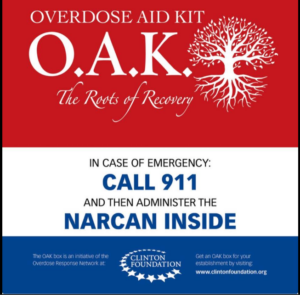My work as Clinical Consultant to The Hyer Calling Foundation continues to bring me impactful industry insight and the opportunity to meet some amazing people doing incredible things.
Today Kevin, Nina, and I had another call with Jessica Geschke, the creator and founder of Overdose Aid Kits (OAK) (https://www.facebook.com/overdoseaidkit). We were joined by Megan Affrunti, and I was very interested and inspired hearing stories about the work they did during the Georgia #GARecovers bus tour with support from the Clinton Foundation.
As Jessica talked about interacting with key stakeholders in the community to be educated about and accept the OAK boxes in their buildings, offices, places of worship, stores, etc…, I was having vivid flashbacks to too many CODE BLUES in the parking lot of the hospital as terrified families and friends came tearing up the driveway with their almost-dead or already-dead loved one in the car overdosing(ed).
Dragging all that medical equipment out the doors and to a car is no easy task. CPR without a flat surface is impossible. Pumping enough naloxone in after all that wasted time is difficult. Trying to comfort terrified, hysterical, furious families is frustrating and heartbreaking.
Going home from your job of saving lives after witnessing another unnecessary death is disheartening; doing it repeatedly is disgusting.
During our conversation, I was flabbergasted to learn that despite mandates and funding, even some schools weren’t stocking naloxone.
Fueled by a recent incident in my granddaughter’s school, involving a child whose family I am familiar with, without hesitation and in full nurse-self-righteousness, I blurted, “Where are the nurses? I can’t imagine that the school nurses wouldn’t be instrumental in educating about and making naloxone available in schools. How could they not, right? It’s what we do- we’re obligated.”
Jessica responded that sometimes the nurses are part of the resistance.
That is not a typo: Sometimes the nurses are part of the resistance.
I was utterly confused and outraged. When we hung up, I started researching.
I confirmed that some schools’ reluctance to stock naloxone can be attributed to officials’ fear of providing a medical service, the ongoing cost of resupplying the medication, and the potential for stigmatization. However, the most pressing concern is that schools are afraid of being seen as places where students use drugs. As a result, naloxone availability and access in schools is not as widespread as automated external defibrillators (AEDs) or fire extinguishers, despite the fact that opioid overdoses are now the leading cause of death among Americans under the age of 50.
This is a serious problem, as it means that students who overdose in schools may not have access to the life-saving medication they need in time. It also means that the younger siblings or older grandparents, fellow students, other staff who work in or visit the school and are accidentally exposed may not have access to the life-saving medication they need in time. It means that the adults and students in that school are denied access to the education needed to potentially save lives outside the school(s).
I pulled up, “Naloxone in the School Setting. Position Statement. Revised- National Association of School Nurses,” and confirmed:
It is the position of the National Association of School Nurses (NASN) that the safe and effective management of opioid-related overdoses in schools must be incorporated into the school emergency preparedness and response plans. The registered professional school nurse provides leadership in all phases of emergency preparedness and response. When emergencies happen, including drug-related emergencies, proper management of these incidents at school is vital to positive outcomes. The school nurse is essential to the school team responsible for developing and implementing emergency response procedures. School nurses in this role should facilitate access to naloxone for quick response in the management of opioid-related overdoses in the school setting. Through community outreach with prescription opioid abuse, misuse and overdose awareness programs, school nurses can provide valuable education and be a useful resource for K-12 students and their families. Furthermore, school nurses can assist families in recognizing the signs and symptoms of substance abuse, support and guide them in locating resources for care, counseling, and even refer students for appropriate treatment of opioid use disorder (OUD). [This position statement was initially adopted in June 2015. It was revised in June 2020.]
On Jessica’s LinkedIn page, I also found this interesting Time article: https://time.com/6304772/preventing-overdose-deaths-harm-reduction-essay/
I very much look forward to supporting The Hyer Calling Foundation in collaborating with Jessica and the OAK effort.
There is so much valuable information and inspiration on Jessica’s social media pages, please join me in following her and amplifying her tireless work.
Here are the links for the GA bus tour and their YouTube page.
https://mobilizerecoveryacross
https://www.youtube.com/@Mobil
Here also is the Overdose Aid Kit facebook page where we post content on the OAK installs they have completed:
http://www.facebook.com/overdo
(FYI- When naloxone was first approved to reverse opioid overdoses, its brand name was “Narcan.” There are now other formulations and brand names for naloxone, but many people continue to call all of these products “Narcan.” However, the proper generic name is “naloxone.” To learn more, see: Naloxone DrugFacts | National Institute on Drug Abuse (NIDA).)

